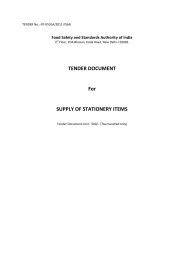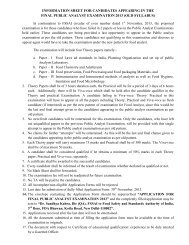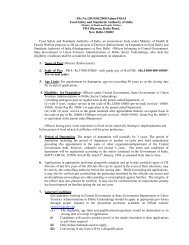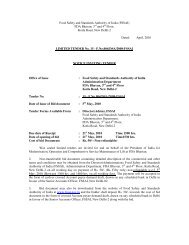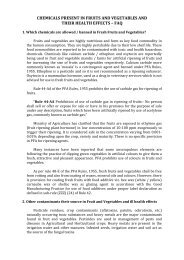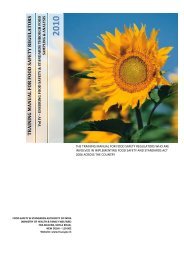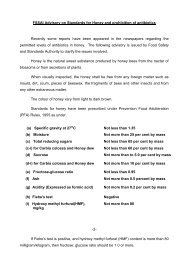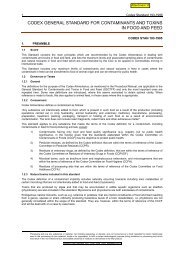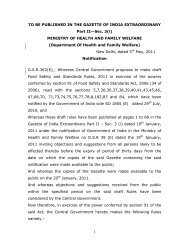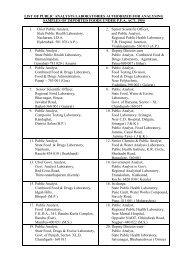Regulation of TFA (Pdf to Save or Print) - Food Safety and Standards ...
Regulation of TFA (Pdf to Save or Print) - Food Safety and Standards ...
Regulation of TFA (Pdf to Save or Print) - Food Safety and Standards ...
You also want an ePaper? Increase the reach of your titles
YUMPU automatically turns print PDFs into web optimized ePapers that Google loves.
2Risk Assessment Rep<strong>or</strong>t on <strong>TFA</strong>s in Indian Diets submitted by National Institute <strong>of</strong>Nutrition, Hyderabad in Oc<strong>to</strong>ber, 20094. On the request <strong>of</strong> FSSAI, NIN carried out a risk analysis <strong>of</strong> transfats in the Indi<strong>and</strong>iet. A summary <strong>of</strong> the findings <strong>of</strong> the rep<strong>or</strong>t is as under:-(a) Not m<strong>or</strong>e than 10% (7% f<strong>or</strong> those with cardiac problems) <strong>and</strong> 1% <strong>of</strong> <strong>to</strong>talenergy can be derived from saturated fat <strong>and</strong> <strong>TFA</strong>, respectively acc<strong>or</strong>ding <strong>to</strong> currentscientific research <strong>and</strong> WHO recommendations, if risk <strong>of</strong> cardio- vascular diseasehas <strong>to</strong> be kept at safe levels. It is imp<strong>or</strong>tant f<strong>or</strong> population <strong>and</strong> individual health that<strong>TFA</strong>s should be removed from the food supply <strong>and</strong> should be replaced by cisunsaturatedfats from vegetable oils rather than saturated fats from tropical oils <strong>and</strong>animal fats.(b) In rural <strong>and</strong> urban India the fat consumption is around 20 <strong>and</strong> 30g /day,respectively, acc<strong>or</strong>ding <strong>to</strong> diet studies (National Consumption Survey data). If 10%<strong>TFA</strong> is permitted in vanaspati, a person consuming 2000Kcal derived from foodwhich contains 20 <strong>and</strong> 30g vanaspati/day will derive 0.9 <strong>and</strong> 1.35 % energy from the<strong>TFA</strong>. (This shows that even at 10% <strong>TFA</strong> level there is health risk at 30g <strong>of</strong> vanaspaticonsumption per day (which exceeds the 1% energy, which is the limit f<strong>or</strong> <strong>TFA</strong>recommended by WHO).(c) Attempts <strong>to</strong> bring down the levels <strong>of</strong> <strong>TFA</strong>s in PHVOs by completehydrogenation <strong>or</strong> higher levels <strong>of</strong> hydrogenation will result in elevated melting point<strong>and</strong> SFA content. This has <strong>to</strong> be viewed with caution as elevation <strong>of</strong> SFAs invanaspati obtained from complete hydrogenation would result in increase in % <strong>of</strong>energy derived from SFAs (not m<strong>or</strong>e than 7% <strong>of</strong> <strong>to</strong>tal energy is <strong>to</strong> be derived fromsaturated fat as recommended by WHO). Increase in intake <strong>of</strong> SFAs will lead <strong>to</strong>increase in serum cholesterol levels <strong>and</strong> Low Density Lipoprotein (LDL) which arepotential risk fac<strong>to</strong>rs f<strong>or</strong> CHD.5. The W<strong>or</strong>ld Health Assembly resolved in 2004 that elimination <strong>of</strong> <strong>TFA</strong> should be akey point f<strong>or</strong> action by governments. WHO/FAO has recently completed an extensivereview <strong>of</strong> latest research on the links <strong>of</strong> <strong>TFA</strong> <strong>to</strong> CVD <strong>and</strong> diabetes <strong>and</strong> recommended thatall countries should take urgent regula<strong>to</strong>ry steps <strong>to</strong> limit transfats in their diet so that cleardanger <strong>to</strong> heart health in vulnerable groups is avoided. Acc<strong>or</strong>ding <strong>to</strong> a rep<strong>or</strong>t in New
3Engl<strong>and</strong> Journal <strong>of</strong> Medicine (Mozaffarian et al, 2006) consumption <strong>of</strong> transfats result inconsiderable potential harm with no benefit. National Academy <strong>of</strong> Sciences, USA hasconcluded that there is no safe level <strong>of</strong> <strong>TFA</strong> consumption, no recommended daily amoun<strong>to</strong>r <strong>to</strong>lerable upper limit as any incremental increase in <strong>TFA</strong> increases the risk <strong>of</strong> c<strong>or</strong>onaryheart disease.6. The implications <strong>of</strong> replacing high <strong>TFA</strong> partially hydrogenated oil by substituteswere also considered by FSSAI. While the availability <strong>of</strong> alternative sources <strong>of</strong> fats is notlikely <strong>to</strong> be a problem, test results <strong>of</strong> the fatty acids pr<strong>of</strong>ile in the market indicate thattechnological solutions are available f<strong>or</strong> reducing trans fats <strong>to</strong> acceptable limits. Industrymay require a suitable time frame f<strong>or</strong> adopting these practices <strong>and</strong> healthier alternatives.Supp<strong>or</strong>t should be given <strong>to</strong> industry <strong>to</strong> communicate the healthier nature <strong>of</strong> its products <strong>to</strong>consumers <strong>and</strong> also help small <strong>and</strong> medium sized enterprises <strong>to</strong> prepare f<strong>or</strong> compliance.The vegetable oil industry should take the lead in this area.7. The experience <strong>of</strong> other countries who have introduced regulation <strong>to</strong> limit trans fatsindicate that Polyunsaturated fatty acids including alpha-linolenic (Omega 3) <strong>and</strong> linoleic(Omega 6) acids are also imp<strong>or</strong>tant components <strong>of</strong> a cholesterol lowering <strong>and</strong> m<strong>or</strong>ehealthful diet. However, the benefits depend <strong>to</strong> some degree on consuming anappropriate balance <strong>of</strong> these fatty acids. The goal, theref<strong>or</strong>e, should be <strong>to</strong> replace, asmuch as possible, trans saturated fats with mono unsaturated fats <strong>and</strong> maintain adequateintake <strong>and</strong> appropriate balance <strong>of</strong> Omega 6 <strong>and</strong> Omega 3 polyunsaturated fatty acids.8. It is also necessary <strong>to</strong> consider appropriate modifications in the edible oilsregulations <strong>to</strong> encourage use <strong>of</strong> all available healthier alternatives. Further research onthese possibilities need <strong>to</strong> be undertaken so that available options are considered <strong>and</strong>appropriate regulations are developed.Current regulations f<strong>or</strong> <strong>TFA</strong>s9. The PFA Rules, 1955 require that:-(a) The foods in which hydrogenated vegetable fats <strong>or</strong> bakery sh<strong>or</strong>tening is usedshall declare on the label that “Hydrogenated vegetable fats <strong>or</strong> bakerysh<strong>or</strong>tening used-contains trans fats”.
5Proposed regulations under FSSAI13. The need was felt <strong>to</strong> regulate the <strong>TFA</strong>s in partially hydrogenated vegetable oils <strong>and</strong>this issue was considered in the Third meeting <strong>of</strong> the <strong>Food</strong> Auth<strong>or</strong>ity held on 26 thNovember, 2009 where it was recommended <strong>to</strong> fix a limit <strong>of</strong> not m<strong>or</strong>e than 10 percenttrans-fatty acids in partially hydrogenated vegetable oils. It was also recommended that anational consultation may also be <strong>or</strong>ganized <strong>to</strong> obtain feedback from consumers <strong>and</strong>industry <strong>and</strong> the scientific community f<strong>or</strong> implementation <strong>of</strong> the regulation.14. In view <strong>of</strong> above, National Institute <strong>of</strong> Nutrition, Hyderabad conducted a nationalconsultation by inviting participants representing all stakeholders on 29.01.2010 whichrecommended the following with regard <strong>to</strong> <strong>TFA</strong> limits :-(a) The <strong>TFA</strong> level in PHVO should be below 10% <strong>and</strong> should not exceed 10%.(b) Existing melting point regulation which is 31°C - 41°C f<strong>or</strong> partially hydrogenatedvegetable oils, bakery sh<strong>or</strong>tening <strong>and</strong> margarines, interesterified vegetable fat<strong>and</strong> other fats made using vegetable oils should be removed in harmonizationwith Codex St<strong>and</strong>ard.(c) Natural hard fractions like Palm Stearin should be included in list <strong>of</strong> edible oils<strong>and</strong> fats in line with Codex St<strong>and</strong>ard.(d) M<strong>and</strong>a<strong>to</strong>ry labelling <strong>of</strong> <strong>TFA</strong> <strong>and</strong> saturated fat content f<strong>or</strong> all edible oils <strong>and</strong> fatsshould be implemented.(e) PFA regulation must allow both chemical <strong>and</strong> enzymatic inter esterification.15. Thereafter the issue was considered in the meeting <strong>of</strong> Central Advis<strong>or</strong>y Committee<strong>and</strong> Scientific Committee <strong>of</strong> <strong>Food</strong> Auth<strong>or</strong>ity which end<strong>or</strong>sed the recommendation <strong>of</strong> a limit<strong>of</strong> 10 % <strong>TFA</strong> in vanaspati <strong>to</strong> be brought down <strong>to</strong> 5% within a period <strong>of</strong> three years.16. An Expert Group constituted by FSSAI also deliberated on the need f<strong>or</strong> fixing the<strong>TFA</strong> limit in vanaspati <strong>and</strong> recommended that level <strong>of</strong> <strong>TFA</strong> in Vanaspati / PHVO, be fixedat the level 10% maximum, <strong>to</strong> be brought down <strong>to</strong> 5% in 3 years. The Expert Group alsosuggested change in the regulations regarding melting point <strong>and</strong> enzymatic esterificationf<strong>or</strong> production <strong>of</strong> vanaspati f<strong>or</strong> regulating trans fatty acids.
617. A large prop<strong>or</strong>tion <strong>of</strong> population in Indian sub continent is identified as geneticallypre-disposed <strong>to</strong> CVD. Consumption <strong>of</strong> vanaspati <strong>and</strong> <strong>TFA</strong> compound the risk <strong>of</strong> CVD inIndian population. It seems appropriate, theref<strong>or</strong>e, that steps are taken in our country <strong>to</strong>minimize the <strong>TFA</strong> intake through dietary fat.18. Taking in<strong>to</strong> account all the above mentioned inputs, the FSSAI proposes thefollowing :-(a)Level <strong>of</strong> <strong>TFA</strong> in Vanaspati / PHVO, be fixed at 10% maximum <strong>and</strong>brought down <strong>to</strong> 5% in 3 years. A phasing in period may be given <strong>to</strong>industry after the date <strong>of</strong> notification. A detailed review <strong>of</strong> the impact <strong>of</strong>the measure should be carried out by the end <strong>of</strong> 3 years <strong>to</strong> decidewhether further reduction can be attempted.(b)There are no substantial studies on detrimental effects <strong>of</strong> raising themelting point <strong>of</strong> vanaspati from current level <strong>of</strong> 41 0 <strong>to</strong> 51 0 <strong>or</strong> <strong>to</strong> removethe melting point limit al<strong>to</strong>gether. On the other h<strong>and</strong>, it has beenargued that high melting point has no deleterious effect on health <strong>or</strong>digestion. N<strong>or</strong> do Codex st<strong>and</strong>ards prescribe an upper limit on meltingpoint. There is need <strong>to</strong> carry out studies f<strong>or</strong> documenting the effects <strong>of</strong>raising / removing the melting point limit on digestion <strong>and</strong> overallhealth. It is, theref<strong>or</strong>e, proposed that presently status quo may bemaintained i.e. melting point <strong>of</strong> 41°C be retained <strong>or</strong> it be raised only <strong>to</strong>the extent that would facilitate bringing down the <strong>TFA</strong> level <strong>to</strong> theabove limits.(c)There is also a need <strong>to</strong> look in<strong>to</strong> the feasibility f<strong>or</strong> laying down thelimits <strong>of</strong> Saturated Fatty Acids (SFAs) in vanaspati <strong>and</strong> other fats. Thisis being thought <strong>of</strong> because if the melting point is raised, it will lead <strong>to</strong>increase in saturation <strong>of</strong> partially hydrogenated vegetable oils. WHOhad recommended that not m<strong>or</strong>e than 1% <strong>and</strong> not m<strong>or</strong>e than 10% <strong>of</strong>energy in diet be derived from <strong>TFA</strong>s <strong>and</strong> SFAs, respectively.(d)Enzymatic esterification f<strong>or</strong> production <strong>of</strong> vanaspati f<strong>or</strong> regulating transfatty acids can be considered. But it being a costly alternative, maytake time f<strong>or</strong> implementation.
7(e)(f)(g)As regards permitting use <strong>of</strong> Palm Stearin in vanaspati, it also needs <strong>to</strong>be looked in<strong>to</strong> whether <strong>to</strong> allow its use <strong>or</strong> not as in our country PalmStearin is used in soap industry. However, there was no safety issue onits use <strong>and</strong> it is allowed in Codex st<strong>and</strong>ards with melting point <strong>of</strong>44°C - 52°C. Palm Stearin after interesterification with another liquidoil like rice bran oil, mustard oil, sunflower oil <strong>or</strong> soybean oil inappropriate ratio is shown <strong>to</strong> produce sh<strong>or</strong>tening similar <strong>to</strong> vanaspatiwith comparable functional properties <strong>and</strong> the product is completelyfree from trans fatty acids. However, Palm Stearin content may bepermitted only in interesterified fat <strong>and</strong> not approved f<strong>or</strong> blending <strong>of</strong>oils <strong>or</strong> <strong>to</strong> be used as such.There should be m<strong>and</strong>a<strong>to</strong>ry labelling <strong>of</strong> <strong>TFA</strong> & SFA content onvanaspati packs, edible oils <strong>or</strong> any other product containing <strong>TFA</strong> fromvanaspati sources. This is necessary <strong>to</strong> enable inf<strong>or</strong>med choice byconsumers.There is currently a limit on blending <strong>of</strong> m<strong>or</strong>e than two oils <strong>and</strong> aminimum requirement <strong>of</strong> 20% f<strong>or</strong> each oil used f<strong>or</strong> blending. Theselimits have been imposed <strong>to</strong> facilitate detection <strong>of</strong> adulteration. Thereis a dem<strong>and</strong> f<strong>or</strong> reviewing this restriction <strong>to</strong> facilitate greater use <strong>of</strong>other oils by industry <strong>and</strong> facilitate balance in SFA : MUFA : PUFAcomponents.19. The above recommendations are likely <strong>to</strong>:(a) Contribute <strong>to</strong> decreasing / removing one <strong>of</strong> the risk fac<strong>to</strong>rs <strong>and</strong>significantly improve the heart health <strong>of</strong> Indian citizens <strong>and</strong> save lives.(b) Reduce daily intake <strong>of</strong> transfats by Indian consumers <strong>of</strong> all age groups<strong>to</strong> between 1% <strong>and</strong> 2% <strong>of</strong> energy intake consistent with current dietaryrecommendations, over a period <strong>of</strong> 3 years.(c) Those at the highest consumption level will benefit from them<strong>and</strong>a<strong>to</strong>ry reduction <strong>of</strong> industrially produced trans fats. Even those with lowconsumption will benefit. Even if small amounts <strong>of</strong> fat is consumed, if it isdevoid <strong>of</strong> <strong>TFA</strong> <strong>and</strong> contains unsaturated fatty acids, the population will st<strong>and</strong><strong>to</strong> benefit.
8(d) Promote the development <strong>of</strong> alternative supplies <strong>of</strong> m<strong>or</strong>e healthfulalternatives <strong>of</strong> trans fats.(e) Provide a level playing field <strong>to</strong> industry <strong>to</strong> compete on the basis <strong>of</strong> thesafety <strong>and</strong> healthy features <strong>of</strong> their products.20. Keeping in view the imp<strong>or</strong>tance <strong>of</strong> the proposed measure in improving health <strong>and</strong>reducing the risk <strong>of</strong> cardiovascular disease <strong>to</strong> a large section <strong>of</strong> the population, <strong>Food</strong><strong>Safety</strong> <strong>and</strong> St<strong>and</strong>ards Auth<strong>or</strong>ity believes that the proposed measure should be widelydisseminated f<strong>or</strong> feedback from all stakeholders. Those desirous <strong>of</strong> commenting on theproposed measure are invited <strong>to</strong> send their comments within 30 days from publishing <strong>of</strong>this note <strong>to</strong> <strong>Food</strong> <strong>Safety</strong> <strong>and</strong> St<strong>and</strong>ards Auth<strong>or</strong>ity. Thereafter, <strong>Food</strong> <strong>Safety</strong> <strong>and</strong> St<strong>and</strong>ardsAuth<strong>or</strong>ity proposes <strong>to</strong> finalise the regulations f<strong>or</strong> submission <strong>to</strong> the Government.Please send your comments <strong>to</strong> :Name : Dr. Dhir Singh, ADG(PFA)E.mail : adgpfa@nb.nic.inContact No. : 23237418Fax No. : 23220994



